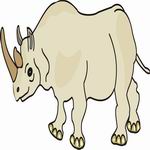- The skin of the rhinoceros is extremely thick, nearly hairless in
most species, and deeply folded in some.
- The horns, arising from the skin, are made of keratin, a fibrous
substance.
- The legs are stout and short and end in broad feet, each with three
toes.
- Rhinoceroses are herbivorous, browsers or grazers according to the
species.
- Most live near water and like to wallow in mud; all swim well.
- They have poor vision but good hearing and a good sense of smell.
- Mostly solitary animals, they feed by night and in the early morning
and evening; they rest in shade during the heat of the day.
- They are often accompanied by small tickbirds (oxpeckers) that feed
on parasites in their skin and, by their cries, alert them to danger.
- Although most rhinoceroses are placid animals, mothers fiercely protect
their offspring.
- A rhinoceros is a heavy animal with a frame, like the elephant, that
is graviportal.
- There is a prominent hump over the shoulders and a thickened ridge
along the neck, evidence of an enormous tendon network to hold up the
huge head.
- All extant rhinos have a horn on the end of the rostrum, the second
horn, if present, is in tandem and smaller.
- The upper lip may be pointed or squared, depending on the species.
- The skin is thick and nearly hairless (except the Sumatran).
- All rhinos are some shade of grey, with long, sparsely wooly reddish
or brown hair on the Sumatran.
- The wide lips of the white rhino are perfect for grazing the short
grasses of the savannah.
- Rhinos are basically solitary and rhinos seen together are usually
female and calf.
- Males reach maturity at 7 or 8 years of age but are prevented from
breeding until they gain social status and claim their own territories
at about age 10.
- All rhino species are endangered.
|


